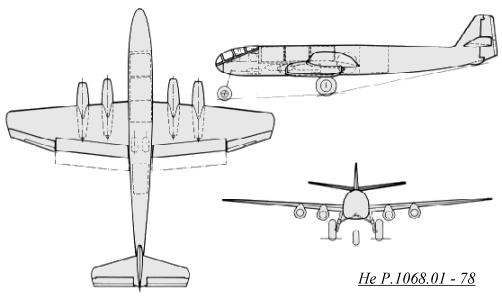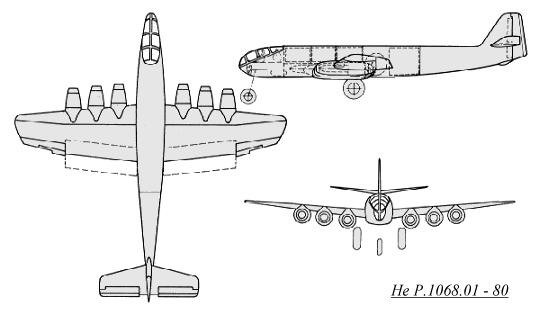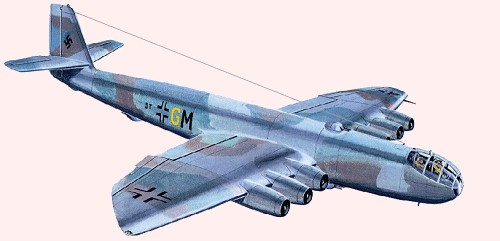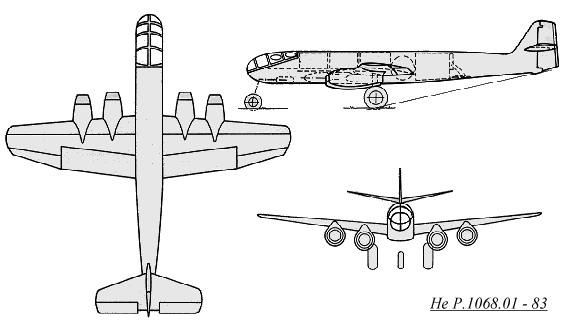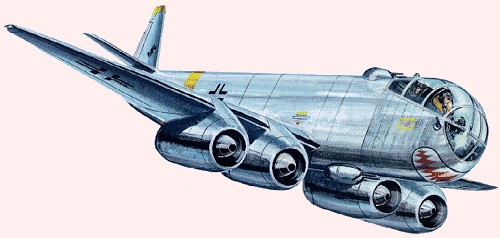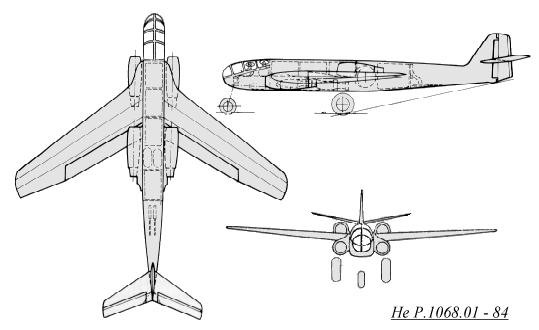| Type | P.1068.01-78 | He P.1068.01-80 | He P.1068.01-83 | He P.1068.01-84 |
| Engine | 4 He S 011 or Jumo 004C | 6 He S 011 or Jumo 004C | 4 He S 011 | 4 He S 011 |
| Dimensions | Length 20 m, height 2,1 m , span 19 m , wing area 60 m2 , fuselage width 1,8 m, wheel track 3,3 m | Length 20 m, height 2,1 m , span 19 m , wing area 60 m2 , fuselage width 1,8 m, wheel track 3,3 m | Length 17 m, height 1,8 m , span 17 m , wing area 43 m2 , fuselage width 1,3 m, wheel track 3,0 m | Length 17 m, height 1,8 m , span 17 m , wing area 45 m2 , fuselage width 1,3 m, wheel track 3,3 m |
| Weights | Empty 12830 kg , loaded 22300 kg, max. take off weight , fuel 7770 kg, oil 170 kg | Empty 14800 kg , loaded 23500 kg, max. take off weight , fuel 7770 kg, oil 170 kg |
Empty 10760 kg , loaded 17960 kg, max. take off weight , fuel 5500 kg, oil 170 kg |
Empty 11060 kg , loaded 18260 kg, max. take off weight , fuel 5500 kg, oil 170 kg |
| Performance | Max.. speed 825 km/h at sea level, 853 km/h at 6000 m, 825 km/h at 10000 m, 795 km/h at 12000 m, cruising speed , range 850 km at sea level, , 1310 km at 6000 m, 1910 km at 10000 m , endurance , service ceiling 11100 m , climb 20 m/sec, | Max.. speed 930 km/h at sea level, 896 km/h at 6000 m, 850 km/h at 10000 m, 835 km/h at 12000 m, cruising speed , range 550 km at sea level, , 830 km at 6000 m, 1170 km at 10000 m , endurance , service ceiling 13200 m , climb 33 m/sec, | Max.. speed 910 km/h at sea level, 888 km/h at 6000 m, 850 km/h at 10000 m, 825 km/h at 12000 m, cruising speed , range 670 km at sea level, , 955 km at 6000 m, 1315 km at 10000 m , endurance , service ceiling 12700 m , climb 28,5 m/sec, | Max.. speed 894 km/h at sea level, 895 km/h at 6000 m, 872 km/h at 10000 m, 842 km/h at 12000 m, cruising speed , range 630 km at sea level, , 960 km at 6000 m, 1350 km at 10000 m , endurance , service ceiling 12500 m , climb 28 m/sec, |
| Armament |
